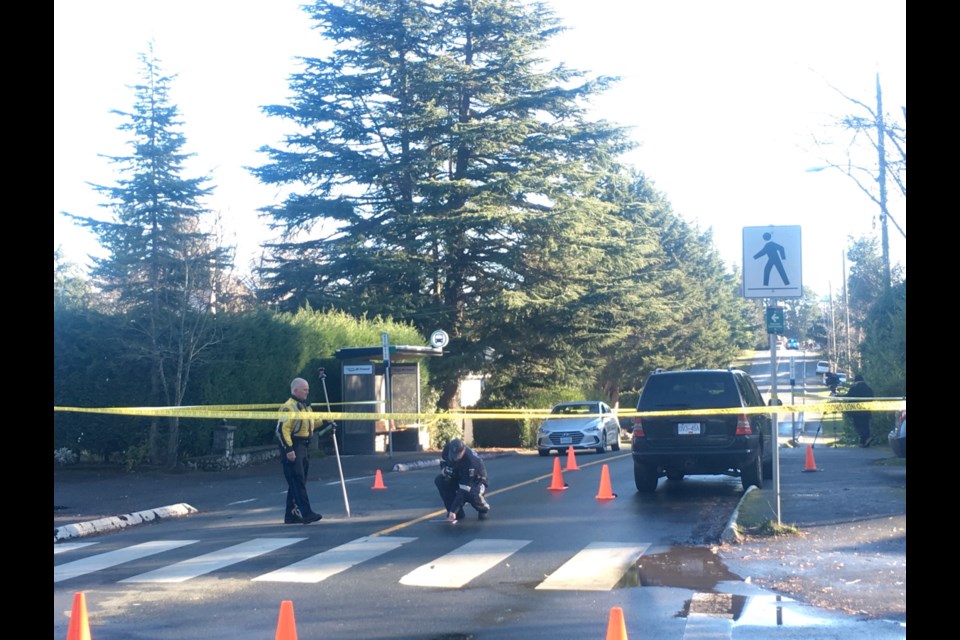The Victoria woman who drove into 11-year-old Leila Bui in a crosswalk two years ago would not have been able to see the child crossing because the girl was obscured by another vehicle, says her lawyer.
Tom Morino was making final submissions Monday in Victoria provincial court at the trial of Tenessa Nikirk, who has been charged with dangerous driving causing bodily harm.
Nikirk, who is in her early 20s, was behind the wheel of a black Mercedes SUV that struck Leila in the crosswalk on Ash Road at the intersection of Torquay Drive on the morning of Dec. 20, 2017. The collision left Leila with severe brain damage.
The defence lawyer reminded the court of the evidence of Xin Hao, who was driving west along Ash Road toward Mount Douglas just before Leila was struck.
Hao testified that Leila checked right and left, then started to run across the crosswalk before she was hit by an eastbound black SUV going about 60 kilometres per hour on Ash.
Morino said Hao was unsure if Leila was obscured from view because of the position of another car, driven by witness Shawn Steele, which had stopped at the intersection to turn onto Ash after heading north on Torquay Drive.
“A 168-centimetre child standing in that crosswalk would have been completely obscured from view,” said Morino. “No vehicle coming up over that hill could have seen through or around Mr. Steele’s vehicle.”
Calculations made by Saanich police collision analyst Const. Dion Birtwistle at Morino’s request show that if Leila ran, she would have been in the crosswalk for a total of .44 seconds. If Nikirk was driving at 50 kilometres per hour, her Mercedes would have been 6.1 metres from the crosswalk and unable to stop.
“She could not possibly have stopped in order to avoid collision with Leila. This was an inevitable accident,” said Morino.
Judge Mayland McKimm said he shared Morino’s concern about the visibility of the child, but Nikirk was texting, speeding and passing where she shouldn’t be passing.
Admissions of fact read into the court record last week show that between 8 a.m. and 8:20 a.m., Nikirk sent 11 text messages and received 13 texts from a 604 number. She received the final text at 8:16, 12 seconds before the collision.
Morino told the court that Nikirk has been receiving death threats since the court released a dash-cam video that shows the accused speeding as she overtook two vehicles on a solid single yellow line while she headed east on Ash Road that morning.
Morino noted that it is not illegal to pass on a solid yellow line and no other drivers or pedestrians were put in danger when Nikirk overtook the two other vehicles.
Crown prosecutor Jess Patterson did not accept Morino’s argument that the collision was inevitable, saying Nikirk engaged in driving behaviour that was objectively dangerous, including tailgating, dangerous passing, speeding and repeated use of her mobile device. “Despite multiple indicators that would have alerted reasonable drivers to the presence of pedestrians, including clearly visible signs and other stopped vehicles, she failed to appropriately reduce her speed or account for pedestrian traffic in the crosswalk,” Patterson said. “She was driving in a manner dangerous to the public.”
Nikirk was engaged in a prolonged texting conversation — all of the texts she received were sent from the same number. When Nikirk received a text, she read it and replied, said Patterson. There was no evidence she was using hands-free technology.
During the trial, expert witnesses testified that Nikirk was travelling at 95 to 100 kilometres per hour in a residential neighbourhood with a speed limit of 50 kilometres per hour. She reduced her speed to 80 kilometres per hour as she travelled up the hill on Ash Road, which was so steep, she couldn’t see what was beyond the crest, said Patterson.
“She was travelling far too fast and the roads were icy and wet. Children were going to school. There were pedestrians and traffic.”
All the other drivers who saw Nikirk arriving at the intersection testified that she was exceeding the speed limit, said Patterson.
Saanich police collision analysts estimated Nikirk’s speed was 53 to 67 kilometres an hour when she struck Leila.
Nikirk also failed to recognize the risks of the yellow-flashing-light intersection, which is visible from 308 metres away, said the prosecutor.
Leila would have been visible to Nikirk if Nikirk had been looking, said Patterson, who referred the court to a number of drawings showing where Steele’s car was at the point of collision.
“Even if he had pulled out, she still would have been visible,” said Patterson, noting that Steele’s Nissan Rogue was 99 centimetres, the same height as Nikirk’s Mercedes, and Leila was taller than that.
Two cars had already stopped at the intersection when Leila stepped into crosswalk, not realizing the speed Nikirk was going, said Patterson.
“Leila was looking both ways. She entered that crosswalk looking both ways,” he said.
Nikirk’s speed and the distraction of receiving the last text message led to the collision, said Patterson.
A reasonable and prudent driver would have reduced his or her speed and would have not have been texting in that area, he said.



